ADATA XPG SX900 (128GB) Review: Maximizing SandForce Capacity
by Kristian Vättö on June 8, 2012 1:25 AM ESTAnandTech Storage Bench 2011—Light Workload
Our new light workload actually has more write operations than read operations. The split is as follows: 372,630 reads and 459,709 writes. The relatively close read/write ratio does better mimic a typical light workload (although even lighter workloads would be far more read centric). The I/O breakdown is similar to the heavy workload at small IOs, however you'll notice that there are far fewer large IO transfers:
| AnandTech Storage Bench 2011—Light Workload IO Breakdown | ||||
| IO Size | % of Total | |||
| 4KB | 27% | |||
| 16KB | 8% | |||
| 32KB | 6% | |||
| 64KB | 5% | |||
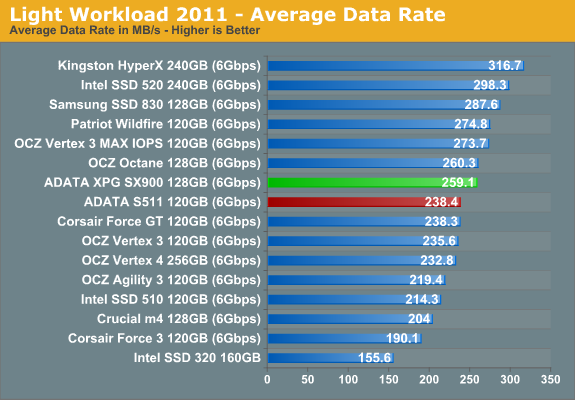
The difference in performance between the SX900 and S511 might seem bigger in our Light Suite, but in terms of percentages it's about the same (the SX900 is 7% faster in our Heavy Suite and 8.7% faster in our Light Suite). Overall performance for the SX900 continues to be similar to other 120/128GB SF-2281 based drives, with firmware and NAND differences causing minor differences in raw performance. In practice, most home users would be hard pressed to notice the difference between the fastest and slowest of these SSDs in day-to-day use.
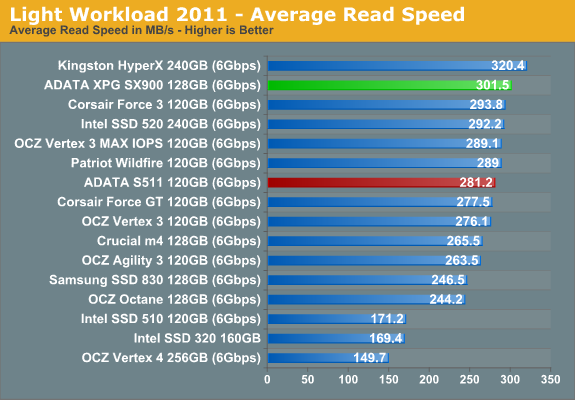
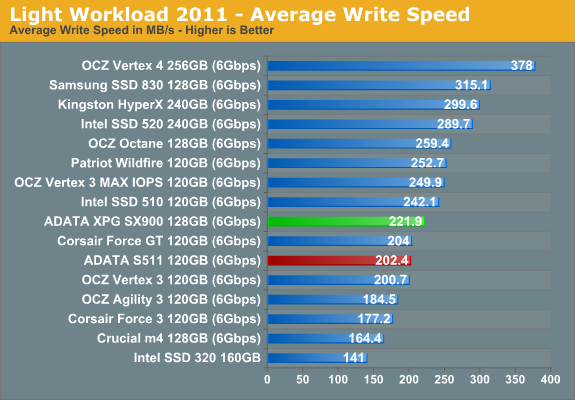

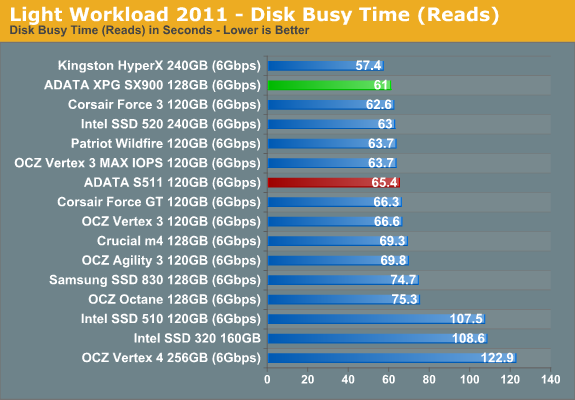
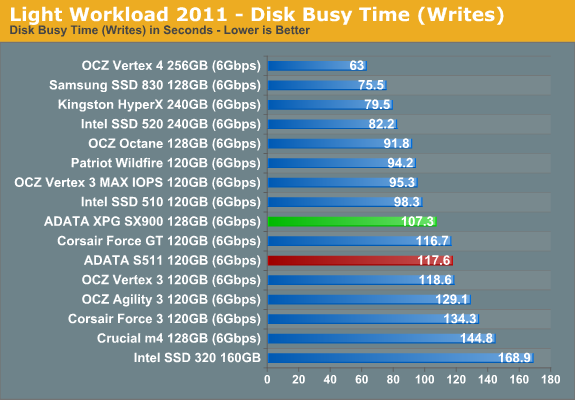










58 Comments
View All Comments
leexgx - Friday, June 8, 2012 - link
use an usa vpn loads of free onesTujan - Friday, June 8, 2012 - link
This is yes "nand",. What would be the complexity of simply creating a curcuit board,that fits regular DDR3 ,and places it into the PCI-e slot. Put a battery onto the board,with perhaps a simplified voltage regulator. Then this saves the state of the RAM when the board shuts off. Would be serous situation for such curcuit boards. Ho-hum save the state of the memory,where no change equals,saved state. Strobe etc,. Even the ideal of having RAM on the curcuit board w/o the saving is a serious relationship to performance 'in session' on a computer of course.Fail to understand reasons vendors would ask so much for such a PCI-e board. When I see a memory curcuit on a MB for example,a fraction of a whole MB,that would just as well be able to fit onto a removabl PCI-e board. For a PCI slot.
jabber - Friday, June 8, 2012 - link
Gigabyte did this about 7 years ago.http://www.anandtech.com/show/1742
jabber - Friday, June 8, 2012 - link
Just not through the PCI-e slot.Einy0 - Friday, June 8, 2012 - link
Thanks for the trip down memory lane!!! I used to day dream for hours about how I would use one of those.Stahn Aileron - Friday, June 8, 2012 - link
In one word: Capacity. Next issue would be power efficieny since you would always be feeding it power in some form (be it main power or battery power. And that battery will only last so long.) The power issue is relative minor point though.The other main power would be volatility. RAM drives are only useful when you absolutely, positively need high-speed, low latency read/write performance (like forcing cache to DRAM instead of the storage system.) As soon as you power them off, you lose all the data stored on them. Battery back-up systems can only go so far to retain your data. This type of storage is too risky for permanent data storage. Any loss of power to the RAM equates to losing all your data. Unlike non-volatile systems (HDDs, SSDs), you're not recovering that data either.
You're not gonna see RAM drive tech in the consumer space unless they can makes non-volatile RAM. Right now, it's mainly an enterprise thing. Even then, with the uptake of 64-bit software during the past decade or so in that market, there's very little need for RAM drives since a 64-bit OS will give you direct access to practically any and all RAM you have installed in a system these days. You don't need a RAM Drive workaround to access more RAM (32-bit OSes have and inherent 4GiB memory space limitation without workarounds.) I can only see RAM drives being used in the consumer/professional space if some software used explicitly required cache/scratch space on a drive. Something like Photoshop scratch space would be better served on a RAM drive, perhaps.
Past that, it's cost. Just the RAM itself is about $10/GB these days (give or take.) Fully assembled SSDs using a common interface (SATA) are averaging between $1 & $2 per GB.
Shadowmaster625 - Friday, June 8, 2012 - link
I have a bricked Sandcrap drive that tells me all that RAISE crap is pretty useless so they may as well just use that NAND for more capacity.Hell, they should just advertise it as a 1TB drive. Once it is bricked, who can ever tell the difference?
DigitalFreak - Friday, June 8, 2012 - link
U mad bro?Belard - Monday, June 11, 2012 - link
Sandforce has become the dominate player in the market. If their controllers were pure crap, then intel wouldn't have touched them. Notice how long intel's G2 drives were THE #1 drives to get, not just in performance but in reliability.I admit, I'm a bit confused that intel didn't continue to use their own controller in their top in drive (Their 320 series are like a "G3" and perform slightly better but cheaper than the G2s).
Also, what sandcrap drive did you get? OCZ makes about 4 different versions of any particular size. Even 6 months ago, you can pick up a 120GB OCZ for $95, but also spend $250... the cheap drive had a much higher failure rate, include DOA. Its performance was crap, becoming slower than a HD after a while.
Was talking with friends who are looking to upgrade soon. They are going over the various drive brands and pricing. I said, "I don't care... intel 320 or 520. Reliability counts. Saving $50 in exchange for BSOD / performance loss / lack of support isn't worth it".
I don't know about other brands, but OCZ has no tools for their drives, other than a firmware upgrader. That's it. Intel has a tool-kit, it tells you everything about the SSD, optimization, config, diagnostics and more.
I'm open to buy a drive from someone else, I'm NOT an intel fan. But I want quality over fandom first.
ImSpartacus - Friday, June 8, 2012 - link
Knowing this was an SSD review, I assumed Anand wrote it. After I read the intro piece, I was CONVINCED that it was Anand. But lo and behold, when I glanced at the top of the next page, I did not see the name I was expected.Bravo, Mr. Vättö, bravo.